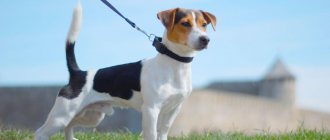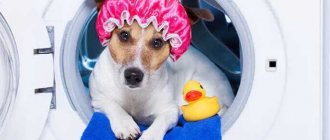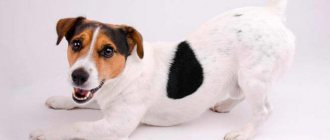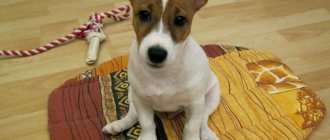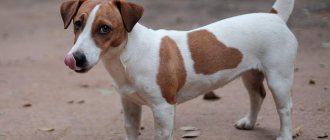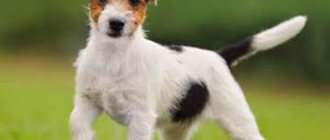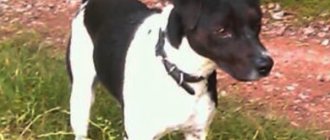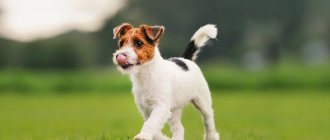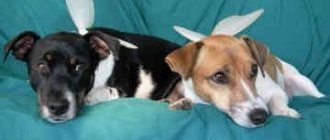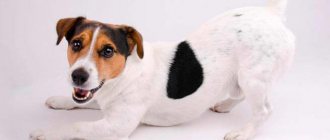Jack Russell Terriers are one of the smartest dog breeds.
They are always on the move, both at home and on the street. Therefore, despite the presence of undercoat, which means they are not very cold, they need clothing for protection. In autumn and spring from mud and water, when the dog rushes through puddles. And in winter, most dogs living in apartments need to be dressed.
Their body is not adapted to negative temperatures. To purchase an outfit for your pet or create one yourself, you need to correctly measure the size of your dog’s clothing.
How to choose
First you need to take all measurements from your pet. The suit itself should be made of durable and waterproof material to protect the dog from getting wet. A winter outfit should have a warm lining inside to protect against the cold. Most often it is made from fleece. And the outer part is made of nylon.
The suit should not have crooked seams or protruding threads. And even more so it should not be defective. The Jack Russell Terrier is an active dog that loves to run and jump regardless of the time of year. And the pet should feel comfortable in a suit, and not vice versa.
Wardrobe must-haves
What you definitely need to buy for Jack Russell dogs include:
- winter overalls on padding polyester with fleece lining inside;
- autumn overalls made of water-repellent fabric, preferably with a hood, as Jack Russells often have problems with their ears. The fabric must be of high quality;
- boots with rubber soles or ugg boots.
IMPORTANT!
Be sure to ensure that the material is of high quality, there are no defects in the seams and no threads sticking out, since the Jack Russell is a very active breed of dog, and damaged clothing will quickly wear out.
Check if the fabric feels pleasant to the touch. It's good if you can discreetly splash water on it to see if it gets wet. The best option for fasteners would be button fasteners - they make dressing the dog more convenient.
Various summer suits are mere decorations and are not part of the required wardrobe.
Choosing a Collar
There are certain rules, subject to which your pet will feel comfortable in a collar:
- two fingers of your hand should fit freely between the dog’s neck and the collar;
- the collar should be so wide that it cannot be removed over the head;
- The collar should not restrict movement or put pressure. The dog should turn and tilt its head freely;
- The collar should be made of a material that does not chafe the skin. Check the material, feel it, is it soft enough?
IMPORTANT!
It is advisable to choose a collar, like a harness, by trying it on the dog. This way you can better assess whether the accessory hinders your pet’s movements.
How to choose a leash and harness?
For dogs of this breed, it is very important to choose a good leash, as they are very active. It is important to provide them with some freedom of movement, but at the same time limit their ability to run forward.
A few simple rules:
- The harness should be made of soft, non-chafing material. It should not be allowed to restrict the dog’s movements;
- A roulette leash is best suited so that the dog can run long distances;
- the leash must be a belt one, as the lace can cut your legs;
- since we choose a tape measure, it is good if the leash is equipped with reflectors, since passers-by often do not notice the leash and stumble over it, which is very unpleasant for both them and the dog;
- the optimal leash length is no more than five meters;
- The leash for a Jack Russell puppy should be light.
How to determine size
Before purchasing, the owner must take all necessary measurements of the dog. Some manufacturers indicate the breed-size ratio. However, focusing on it is risky - the outfit may turn out to be small or large. When choosing clothes, you should proceed only from the measurements of the pet itself.
Taking measurements is quite simple. To do this, you need to measure the circumference of the neck along the line of the collar, the volume of the chest just behind the front paws and the length along the back from the base of the neck (withers) to the tail. For shoes, measure the length and width of the paw. The dog's paw is placed on a white sheet of paper, circled and the above parameters are measured.
After taking all the measurements, you can start ordering an outfit or going to the pet store.
How to take measurements?
Any housewife who is at least a little familiar with needlework can easily knit clothes for her pet with her own hands, but in order to do this she will definitely need a pattern. In order to make a pattern, as in the case of sewing clothes for people, you need to take the measurements correctly.
When taking measurements from an animal, it must be in a motionless state, so it would be advisable to ask someone to help and hold the dog while it is measured. You should also make sure that the measuring tape can rotate freely, but it should not dangle, and then the outfit on your pet will fit well and will not hinder its movements.
Features of tailoring
What should you pay special attention to when sewing clothes for a dog? Of course, safety, comfort and practicality.
Remember that the dog is active and clothes should not interfere with it. Add 2-3 cm to the pattern, not counting seam allowances. Things for a boy should be shorter across the stomach than for a girl, due to his physiological characteristics.
When choosing fabric or yarn, give preference to natural materials or at least 50% natural fibers (wool, cotton). Clothes should be cleaned and washed well, dry quickly, and should not be ironed.
Fasteners should be as secure as possible - Velcro and zippers. Choose plastic snakes with large links. Be sure to make a bar under the zipper to prevent dog hair from getting into the zipper. All decorative elements must be firmly sewn or glued.
Results
Harsh weather conditions, living in large cities where reagents are scattered every winter force Jack Russell Terrier owners to think about purchasing a warm suit. Clothing will prevent the pet from getting severe frostbite, will protect it from gusty winds and rain, and shoes will prevent the influence of reagents on the paw pads. The question of buying an outfit is individual: some dogs, especially long-haired breeds, easily survive the winter, for others frosts turn into a serious problem.
Does a Jack Russell need clothing?
To the question whether a Jack Russell needs clothes, you can confidently answer - yes, dogs of this breed definitely need clothes. This is a must when caring for a Jack Russell.
Some people think that the main purpose of dog costumes is to attract attention and to decorate the pet, but this is not true. The fact is that small dogs with short hair are poorly adapted to walks in bad weather.
If you walk a Jack Russell without clothes, the dog can get a bad cold and then it will have to be treated for a long time. The consequences of a cold in animals can be dire, including death.
What else affects the lifespan of a Jack Russell Terrier, read here.
So you should take care of your pet in advance and insulate it well.
We knit ourselves
You don’t have to buy all these things in stores - you can knit clothes for dogs with your own hands. This will require very few items and a little patience and skill.
What you need
What do you need to knit a sweater for a dog? Not as much as it might seem. Tools:
- knitting needles or crochet hook;
- scissors;
- rubber;
- threads;
- centimeter, pen and piece of paper for taking measurements;
- needle.
This is probably all that is needed in addition to the yarn already purchased. But knitting threads are a separate matter. The choice of yarn will be entirely up to you and depend on the purpose for which the sweater is knitted. The main qualities that threads must have are:
- naturalness;
- the ability to ensure good thermoregulation (in cold weather - warm, in warm weather - do not overheat the pet);
- convenience.
Therefore, avoid purchasing synthetic yarn that is scratchy. For a summer version of a blouse, you can buy cotton threads. For the winter, you can knit a sweater made of mohair, wool and acrylic for your pet.
Avoid cheap, low-quality yarn, especially those made in China. It may contain harmful substances that can cause allergies.
Instructions - how to knit a sweater
How to knit a sweater for a dog? The following instructions will help beginners.
- Work should begin by taking measurements. For dogs of the same breed, standard measurements may be suitable, which can be found in the master classes provided on the Internet. But still, in order for the product to fit well, it is best to make the measurements yourself. You need to know the following parameters: leg girth, back and tummy length, chest girth.
- The first step is to determine the knitting density for each specific yarn. To do this, knit a small sample of the selected pattern with knitting needles and count how many loops fit into 1 cm.
- Now count the number of loops based on the dog’s measurements. For example, by multiplying the number of loops per 1 cm circumference of the chest, we find out how many of them there will be in this part of the sweater.
- When knitting a sweater for a dog, you always start with the collar. In this part of the garment, the number of loops should be less than in the chest circumference. Therefore, from the number of loops in the girth, subtract 20 pieces (for small dogs) and 30 for larger ones. Cast on the resulting number of stitches onto the needles.
- Let's start knitting the neckline. Divide the total number of stitches cast on by 5. Knit the first and last part with an elastic band 1*1, and knit the rest with stockinette stitch.
- Where you knitted with satin stitch, you will begin to create rows for the back, and where with an elastic band - for the tummy. In every second row, add loops to expand. At the same time, those that are added from the elastic side are included in its pattern, and those that are knitted are knitted in satin stitch. In this way we knit 10 rows (you get 5 increments of 4 loops each) for the Yorkshire Terrier, for the Jack Russell - 16 rows.
- Don't forget about the holes for the legs - they need to be made approximately 5-7 cm from the starting row. They are easy to knit: on the front row, knit 3-5 elastic loops, close them, then knit 3-5 stitches with satin stitch. Now knit all the satin stitches except the last 3-5 and bind them off. Close the elastic loops, knit the last 3-5 loops according to the pattern.
- Then, on the purl row, cast on air stitches in an amount equal to the closed loops in the previous row. In the next front row, knit the cast-on loops with an elastic band.
- Now knit the sweater to the very end of the tummy. Don’t forget to gradually make decreases so that the blouse narrows and the belly of the finished product does not hang. To do this, in every 8 row, 2 loops (adjacent satin stitch and elastic) are knitted together. Where the tummy ends, transfer the elastic loops to separate knitting needles and now knit only the back stitch.
- We knit the bottom of the blouse with an elastic band - about 6-8 rows.
- The sweater knitted by hand is almost ready, now all that remains is to sew its details along the edge loops.
Knitting pattern
A sample (about 10-12 cm) is no small thing. We cast on loops on 2 knitting needles, then transfer them to 1 knitting needle, and use the 2nd knitting needle to knit the selected pattern. It is advisable to wash the sample, perhaps the yarn will shrink, then calculate the number of loops for the pet.
After all, it is this small detail that will help you accurately calculate the required number of loops for any part of the sweater.
Knit stitch - knit one row with only knit stitches, the next with purl stitches, then repeat the rows.
All this is done before the knitting stage.
Advice!
It is advisable to outline a small plan and draw a pattern, recording all the measurements and converting everything into loops.
Content
This breed of dog can be safely kept both in a country house and in a city apartment. But in the city there will not be enough physical activity. Walking in the city will be complicated by the fact that the Russell needs to be kept on a leash near highways and noisy gatherings.
Need for physical activity
When walking with your Russell, you need to play, let him run around and keep him company. The dog is highly active and curious. In areas with questionable coverage, it is better to use a muzzle. You need to walk for at least two hours and at least twice a day. This is not even necessary to cope with natural needs, since the Russell can be tamed to use the toilet. Walking is necessary to maintain the dog's physical health.
Appearance care
The coat of an individual can clean itself, so you need to bathe the dog as it gets dirty. Smooth-haired animals shed twice a year, while wire-haired ones need to be combed and trimmed. After the haircut, it is recommended that the dog walk around in clothes for a couple of days to get used to it.
Girls must be bathed after the end of their heat. The dogs are also bathed before each show.
Nutrition
There are no special nutritional requirements, since the breed was formed with an emphasis on endurance and performance. The main condition is maintaining a balanced diet, taking into account large energy losses. It is better to make a choice in favor of high-quality food or a special diet for active dogs. If you feed with natural food, then the main recommendations will be the words of the breeders.
You can also read the full nutrition article for this Jack Russell Terrier.
How to choose a muzzle?
Some people believe that a muzzle is only needed to protect people from large dogs, but this is not true. One of the main purposes of a muzzle is to protect the dog, to prevent the possibility of it eating something spoiled or planted by dog hunters.
It is better, of course, to wean your dog from taking food on the street and from passers-by while still a puppy. Usually, for this purpose, they take a lesson from a professional dog handler, but the technique is quite simple - a random passerby is asked to give the dog food, and if it reaches out to it and tries to take it, the trainer reacts sharply and lightly hits the dog. You cannot harm the animal, but it is important to wean it off the idea of taking food from strangers. After the dog leaves the stranger, the owner gives the pet food from his own hand.
Read more about how to raise and train a Jack Russell here.
So, how to choose a muzzle for your Jack Russell Terrier?
First you need to determine the required dimensions:
- measure the length of the Jack Russell's muzzle - from the tip of the nose to the transition of the muzzle to the forehead;
- muzzle circumference (measure the widest part and add three centimeters);
- head length - from the tip of the nose to the occipital protuberance;
- neck circumference - measure behind the occipital protuberance;
- distance between eyes;
- distance between ears.
It is best, again, to measure directly on the dog.
NOTE!
Inspect the product - there should be no threads or even minor damage or fishing lines. The straps are durable and not stretched. The rivets must be made of metal (for all dogs larger than pugs), otherwise the muzzle will break.
Decide why the muzzle will be used, since different variations are suitable for different purposes:
- A blind leather muzzle completely covers the dog's mouth. It is used for trips to the veterinarian, leading an aggressive dog through a crowd of people, during training. It serves only to protect people from being bitten. Such muzzles can only be worn for a few minutes, because it is very difficult for the dog to breathe in them. They are allowed only when there is noticeable aggression;
- mesh leather muzzles consist of straps. In such a muzzle, the dog can open its mouth, stick out its tongue, and drink water. It does not interfere with breathing and is suitable for daily wear. However, a mesh muzzle does not prevent your dog from eating unwanted food and objects. To solve this issue, you can find a model with a “solid” or almost “solid” bottom and the widest possible distances between the belts on the sides;
- metal mesh is a muzzle that does not interfere with the dog’s eating, drinking and breathing. Very heavy, so it is suitable only for adult strong dogs. In fact, it only protects against bites (even if the dog wants to bite), therefore it is useless for calm dogs. You should not wear it in cold weather, as there is a risk of frostbite and hypothermia;
- A plastic muzzle is, in fact, an analogue of a metal one, but it is much lighter and the mesh is more dense, so the dog cannot pick up anything from the ground. Not every day is suitable for walking in a plastic muzzle, since in hot weather the Jack Russell will be uncomfortable, and in cold weather the material may be damaged;
- a fabric muzzle is a simple formality to comply with the law (for walking in crowded places and transportation). Does not limit the dog in anything;
- bridle - does not limit the dog’s ability to bite or pick up something, but can be used to correct unwanted movements during training. Also suitable for formal legal compliance.
Melange sweater
Dog weight: 12-15kg.
We will need:
- melange yarn, composed of 77% acrylic, 20% wool, 3% polyamide (50g per 70m) – 150g;
- knitting needles No5 and No6.
Patterns:
- cutting: 2l.x2i.;
- persons Ch.: alternate p. persons p. with a row of purl.
Density: face. Ch. 12p. for 19 rub. will be 10cm by 10cm.
Description
Back
Using knitting needles No. 5, cast on 50 stitches. and knit 8p. cutting Let's go to sp. No6 and persons. Ch.
At an altitude of 36 rubles. (19 cm) on both sides we decrease the loops, retreating 2 stitches. from the edge: 2l., 2p. in 1 sheet, faces. to the extreme 4 p., 1 simple broach, 2 l. In 2 rubles repeat the decrease.
On the remaining 46p. let's continue working. Having knitted 58r. (30cm), move on to cutting with knitting needles No. 5. We knit 16 rubles. (this is 8cm) and closed. P.
Tummy
Using knitting needles No. 5, cast on 26 stitches. and do 8 rubles. cutting Let's go to sp. No6 and persons. Ch. From 36r. (19cm) on both sides we decrease by 1 stitch, as described for the back. We repeat the decrease through the row. There are 22 stitches left, on which we knit evenly. From 58r. (30 cm) using knitting needles No. 5, we knit a sweater for a dog using cut knitting. We knit 16 r. (8 cm) and close. P.
Mittens
Sp. No5 dial 26p. and knit 12 rubles in the round. (6cm) cutting. We do not close the loops. We knit the second sleeve in the same way.
Assembly
We sew the upper sections of the cutting. We sew the sleeves with a loop stitch. We make the side seams.
Typical diseases of this breed
The health of a pet and its physical development greatly depend on the person, his attitude and conditions of detention. But the puppy’s heredity, vaccinations and the reputation of the breeders matter.
Among hereditary diseases there are:
- displacement of the eye lens
- progressive retinal atrophy
- ataxia - loss of coordination and loss of balance
- There are also cases of luxating the kneecap, von Willebrand disease and Legg-Calvé-Perthes disease.

